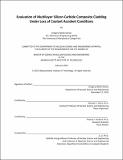Evaluation of multilayer silicon carbide composite cladding under loss of coolant accident conditions
Author(s)
Daines, Gregory Welch
DownloadFull printable version (9.876Mb)
Alternative title
Evaluation of multilayer SiC composite cladding under LOCA conditions
Other Contributors
Massachusetts Institute of Technology. Department of Nuclear Science and Engineering.
Advisor
Michael P. Short.
Terms of use
Metadata
Show full item recordAbstract
Silicon carbide (SiC) has been proposed as an alternative to zirconium alloys used in current light water reactor (LWR) fuel cladding because it exhibits superior corrosion characteristics, high-temperature strength, and a 1000°C higher melting temperature, all of which are important during a loss of coolant accident (LOCA). To improve the performance of SiC cladding, a multilayered architecture consisting of layers of monolithic SiC (mSiC) and SiC/SiC ceramic matrix composite (CMC) has been proposed. In this work, the mechanical performance of both the tubing and the endplug joint of two-layer SiC cladding is investigated under conditions associated with the LOCA. Specifically, SiC cladding mechanical performance is investigated after exposure to 1,400°C steam and after quenching from 1,200°C into either 100°C or 90°C atmospheric-pressure water. The samples consist of two-layer SiC, with an inner SiC/SiC CMC layer and an outer monolith SiC layer. The relationship between mechanical performance and sample architecture is investigated through ceramography and internal void characterization. The two-layered SiC cladding design offered an as-received failure hoop stress of about 600 MPa, with little strength reduction due to thermal shock, and the tube failure hoop stress remained above 200 MPa after 48 hour high-temperature steam oxidation. The cladding showed pseudo-ductile behavior and failed in a non-frangible manner. The designs investigated for joint strength offered as-received burst strength above 30 MPa, although the impact of thermal shock and oxidation showed possible dependence on architecture. Overall, the cladding showed promising accident-tolerant performance. Because the implementation of SiC is complicated by the need for an open gap and low plenum pressure, thorium-based mixed oxides (MOX) are a promising fuel for SiC cladding because they have higher thermal conductivity and lower fission gas release (FGR). Previous efforts at MIT have modified the FRAPCON code to include thorium MOX fuel. In this work, the fission gas release and thermal conductivity models of FRAPCON-3.4-MIT are validated against published data. The results of this validation indicate a need to update the FGR model, which was accomplished in this work.
Description
Thesis: S.M., Massachusetts Institute of Technology, Department of Nuclear Science and Engineering, 2016. This electronic version was submitted by the student author. The certified thesis is available in the Institute Archives and Special Collections. Cataloged from student-submitted PDF version of thesis. Includes bibliographical references (pages 160-164).
Date issued
2016Department
Massachusetts Institute of Technology. Department of Nuclear Science and EngineeringPublisher
Massachusetts Institute of Technology
Keywords
Nuclear Science and Engineering.